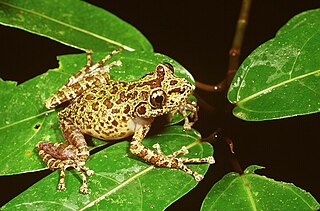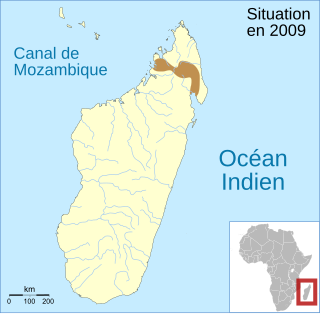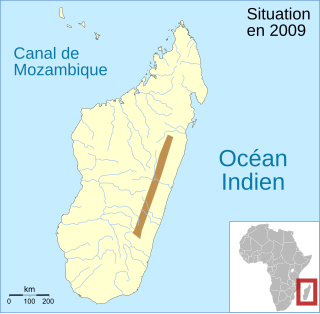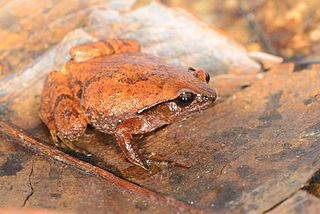
Plethodontohyla is a genus of microhylid frogs endemic to Madagascar.

Stumpffia is a genus of microhylid frogs that are endemic to Madagascar. They are mostly brown frogs that typically live among leaf litter. S. contumelia has a snout–vent length of about 8–9 mm (0.31–0.35 in), making it one of the world's smallest frogs, and several others in the genus are only slightly larger. The largest species is no more than 28 mm (1.1 in).

Spinomantis peraccae is a species of frog in the mantellid subfamily Mantellinae. It is endemic to Madagascar and widely distributed in the northern, eastern, and central parts of the island. The specific epithet honours Italian herpetologist Mario Giacinto Peracca. Common name Peracca's Madagascar frog has been coined for it.

Gephyromantis pseudoasper, also known as the Massif Madagascar frog, is a species of frog in the family Mantellidae. It is endemic to northern Madagascar. It occurs in both pristine and degraded rainforests and in secondary vegetation at elevations up to 900 m (3,000 ft) above sea level. It can be found both on the ground and in trees. Breeding takes place in streams.

Rhombophryne minuta is a species of frog in the family Microhylidae. It is endemic to northern Madagascar. It has been mixed with other species such as Rhombophryne mangabensis; it is known with certainty only from the Marojejy National Park.
Rhombophryne testudo is a species of frog in the family Microhylidae. It is endemic to Madagascar.

Rhombophryne is a genus of microhylid frogs endemic to Madagascar. It is currently estimated to include more than 23 species, but only 20 of these are currently described. The common name 'diamond frog' has been proposed and used for members of this genus.

Anilany helenae is a species of frog in the microyhlid subfamily Cophylinae. It is the only species in the monotypic genus Anilany, and is endemic to central Madagascar.
Boophis baetkei is a species of frog in the family Mantellidae. It is endemic to northern Madagascar and only known from its type locality on the eastern edge of the Fôret d'Ambre Special Reserve in the Antsiranana Province. It is an arboreal species that was found in a heavily disturbed transitional forest. It is threatened by severe habitat loss occurring in the area of its type locality.

Pararhadinaea is a monotypic genus of snakes in the family Pseudoxyrhophiidae. The only species is Pararhadinaea melanogaster, sometimes known as the Madagascar burrowing snake. It is endemic to the island of Madagascar.

Rhombophryne coudreaui is a species of frog in the family Microhylidae. It is endemic to northeastern Madagascar. The specific name coudreaui honours Jean Coudreau, a colonial forestry administrator in Madagascar who collected the holotype. Common names Coudreau's frog and Betampona digging frog have been coined for it.

Plethodontohyla alluaudi is a frog belonging to the Madagascar-endemic subfamily Cophylinae of the family Microhylidae. It is endemic to southeastern Madagascar. It is a terrestrial and fossorial frog that occurs in rainforest, including littoral forest. Despite being locally abundant, it is a difficult frog to find.

Rhombophryne coronata is a frog of the family Microhylidae. It is endemic to eastern Madagascar.

Rhombophryne serratopalpebrosa is a species of frog of the Madagascar endemic microhylid subfamily Cophylinae. Genetic evidence revealed that it is a species complex, in need of resolution. This work has made significant progress, and five related species have been described from this complex between 2014 and 2017. It is threatened by habitat loss.
Rhombophryne guentherpetersi is a frog of the family Microhylidae. It is endemic to northern Madagascar and known from the Tsaratanana Massif. It inhabits high-elevation forest and, perhaps, montane grassland, at elevations of 2,000–2,600 m (6,600–8,500 ft) above sea level. It is a rare species that suffers from habitat loss and degradation. It occurs in the Tsaratanana Reserve but the reserve borders are ambiguous, complicating management of the area.

Rhombophryne vaventy is a large species of frogs of the Madagascar endemic microhylid subfamily Cophylinae. It is one of the largest members of its genus.
Stumpffia kibomena is a species of frog in the family Microhylidae. It is endemic to the Andasibe region of eastern Madagascar. The species is diurnal, and found in primary, secondary, and eucalyptus forests. It has not yet been assessed by the IUCN Red List.

Rhombophryne botabota is a medium-sized species of frogs of the Madagascar endemic microhylid subfamily Cophylinae. It is found in the montane rainforests of northern Madagascar. It was described in 2016 from seven specimens.

Rhombophryne ellae is a species of frog in the family Microhylidae. It is endemic to Montagne d'Ambre National Park in the northern Madagascar. The species was discovered soon after it was possibly forced out of its habitat by Cyclone Ava.















